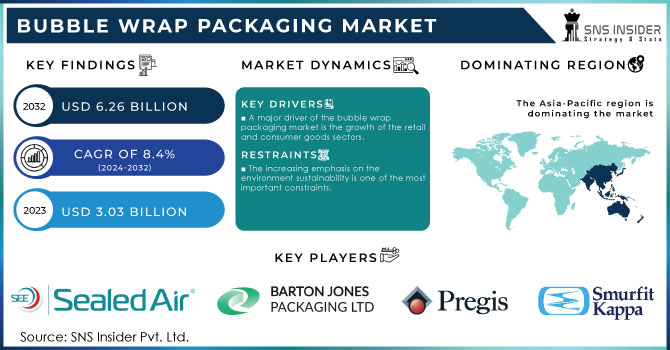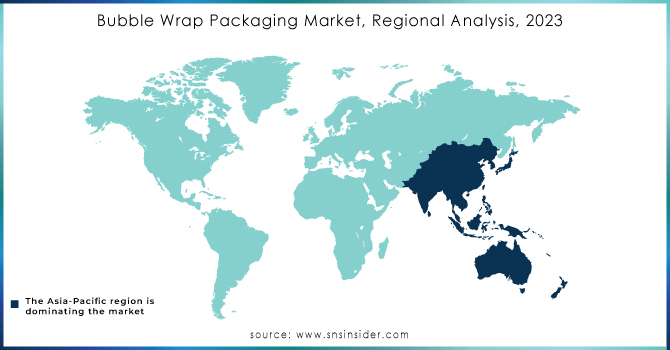Bubble Wrap Packaging Market Report Scope & Overview:

Get More Information on Bubble Wrap Packaging Market - Request Sample Report
The Bubble Wrap Packaging Market size was USD 3.03 billion in 2023, which is forecast to increase to US 6.26 billion by 2032 and grow at a compound annual growth rate of 8.4 % between 2024 and 2032.
Bubble wrap refers to the transparent plastic material used to wrap items to protect them from damage. This material is commonly used as protective packaging consisting of a double-layer polyethylene film. They are typically manufactured using materials such as low-density polyethylene, high-density polyethylene, and linear low-density polyethylene.
One of the main drivers for the growth of the bubble wrap market is the increase in online shopping globally. The rise in innovation and improvement of bubble wrap by manufacturers and growing concern among e-commerce players about product safety are driving the growth of the market. Increasing mergers and acquisitions to meet new demand and raise awareness of the benefits of online shopping such as faster shipping, easier return policies and free shipping are affecting many more to the market. In addition, increasing knowledge about protective packaging, raising awareness, changing consumer preferences and increasing number of electronic models online are positively influencing bubble wrap market. In addition, the launch of temperature-controlled bubble film and high-quality bubble film offers profitable opportunities for market participants during the forecast period.
On the other hand, the availability of alternative packaging such as foam packaging and recycled paper which is relatively cost-effective and environmentally friendly is expected to hinder the growth of the market. The market for bubble wraps is likely to be challenged over a forecast period due to the concerns related to environment.
MARKET DYNAMICS
KEY DRIVERS:
-
A major driver of the bubble wrap packaging market is the growth of the retail and consumer goods sectors.
As the retail market expands, both online and in physical stores, the need for protective packaging solutions like bubble wrap increases. This demand is driven by the need to protect products during transit, improve visual appeal on shelves, and ensure product quality upon delivery. As consumer preferences shift to convenient, ready-to-use products, effective packaging becomes essential to maintaining brand reputation and customer satisfaction. This element underscores the importance of bubble wrap in maintaining product integrity and supporting the dynamic retail landscape.
-
The demand for protective packaging materials is significantly increased by the rapid growth of online shopping.
RESTRAIN:
-
The increasing emphasis on the environment sustainability is one of the most important constraints.
As the retail market grows, both online and in physical stores, the need for protective packaging solutions like bubble wrap increases. This demand is driven by the need to protect products during transit, improve visual appeal on shelves, and ensure product quality upon delivery. As consumer preferences shift to convenient, ready-to-use products, effective packaging becomes essential to maintaining brand reputation and customer satisfaction. This element underscores the importance of bubble wrap in maintaining product integrity and supporting the dynamic retail landscape.
-
More stringent rules are being put in place by the governments and regulatory authorities of various regions concerning single use plastics as well as nondegradable materials.
OPPORTUNITY:
-
Businesses may explore opportunities to increase their presence on the market.
Regions may have a growing need for protective packaging solutions, especially in emerging economies where e-commerce and manufacturing activities are increasing.
-
The bulk purchase of protective packaging material could be facilitated by working together with e commerce platforms and marketplaces.
CHALLENGES:
-
It can cost a lot of money to develop and produce viable or innovative bubble wrap alternatives.
Balancing the need for cost-effective solutions while meeting performance and environmental requirements can be a challenge for businesses, especially smaller ones with limited budgets. regime.
IMPACT OF RUSSIA-UKRAINE WAR
Russian Ukrainian ceramics have had a negative impact on the global market. The European region has been hit hard by the conflict. The main reason is due to high oil and energy prices. Oil price increased to 112 USD/barrel. The raw material needed to produce plastic is petroleum. But rising prices have reduced overall production, which has affected the sustainability goals of large companies. For this reason, companies have turned to traditional packaging methods to reduce costs. Protective packaging is expensive compared to traditional packaging methods.
The imports and exports of electronics and automotive products was reduced compared to previous years, which also affected the market. The sanctions imposed on Russia's finance and transport sectors also hamper exports to that country. In addition, over a thousand international companies have stopped doing business in Russia. The vast majority of Russia's imports from East Asia are technological products, for example machines, equipment and related parts East Asian countries also play an important role in supplying technology products to Russia. They represent about 40% of Russia's machinery and vehicle imports, close to 60% of the vessel import as well as 70% of its electrical equipment.
Energy products account for about 65% of total EU imports from Russia. 30% of EU oil imports and 40% of total gas imports come from Russia. In Estonia, Poland, Slovakia and Finland, more than 70% of their oil imports come from Russia.
IMPACT OF ONGOING RECESSION
Due to the economic downturn in the United States and Europe, volatility in commodity prices affected activity, but not year-over-year activity. Output fell 2.1% by the end of 2022, a level that companies will overcome in a few months.
Due to the economic downturn, the demand for the personal care & automotive industry decreases, which can lead to a 7% drop in sales, which will affect bubble wrap packaging.
KEY MARKET SEGMENTATION
By Material
-
LDPE
-
LLDPE
-
HDPE
By Product Type
-
Bubble Sheets
-
Bubble bags/mailers
By End Use
-
E-commerce
-
Consumer Goods
-
Pharmaceuticals
-
Automotive
-
Others
E-commerce dominated the market and will growth with the fastest growth rate over the forecast period The increase in online shopping has brought about protective packaging, for example bubble wraps, so that the product can be delivered safely to customers.
REGIONAL ANALYSIS
The Asia-Pacific holds the largest market share in the bubble wrap packaging. This is due to the presence of economies such as India, China which are manufacturing hub. There is the rise in the ecommerce industry in this region which is boosting the market growth.
North America is the second largest growing market, due to high demand for packaged products. There is also penetration of many e commerce companies in this region, which is adding to the growth of the market. US market holds the largest market share in this region, followed by the Canada and Mexico.
Europe’s bubble wrap packaging market is the third largest market in term of revenue. The is a high demand for the sustainable packaging and paper bubble wrap is dominating the market in this region. Germany is the dominating the market followed by UK which is the fastest growing market.

Get Customized Report as per your Business Requirement - Request For Customized Report
REGIONAL COVERAGE:
North America
-
US
-
Canada
-
Mexico
Europe
-
Eastern Europe
-
Poland
-
Romania
-
Hungary
-
Turkey
-
Rest of Eastern Europe
-
-
Western Europe
-
Germany
-
France
-
UK
-
Italy
-
Spain
-
Netherlands
-
Switzerland
-
Austria
-
Rest of Western Europe
-
Asia Pacific
-
China
-
India
-
Japan
-
South Korea
-
Vietnam
-
Singapore
-
Australia
-
Rest of Asia Pacific
Middle East & Africa
-
Middle East
-
UAE
-
Egypt
-
Saudi Arabia
-
Qatar
-
Rest of Middle East
-
-
Africa
-
Nigeria
-
South Africa
-
Rest of Africa
-
Latin America
-
Brazil
-
Argentina
-
Colombia
-
Rest of Latin America
Key Players
Some major key players in the Bubble Wrap Packaging market are Sealed Air Corporation, Barton Jones Packaging Limited, Pregis Corporation, Smurfit Kappa, IVEX Protective Packaging Inc, Jiffy Packaging Co, Veritiv Corporation, Automated Packaging Systems and other players.
RECENT DEVELOPMENTS
-
In order to help firms reach the 30% recycled content target in the UK and EU Plastics Treaty, Sealed Air has launched a new range of protection packaging using its BUBBLE WRAP brand. Together with other sustainability objectives, by 2025 in all packaging made of plastics.
-
The North American launch of the Geami MS Mini Packaging System, a sustainable, biodegradable, recyclable and plastic free alternative to traditional plastic bubble wrap, was announced by Ranpak Holdings Corp, a global leader in environmentally sustainable, paper based packaging solutions for e.Commerce and industrial supply chains.
| Report Attributes | Details |
| Market Size in 2023 | US$ 3.03 Bn |
| Market Size by 2032 | US$ 6.26 Bn |
| CAGR | CAGR of 8.4 % From 2024 to 2032 |
| Base Year | 2023 |
| Forecast Period | 2024-2032 |
| Historical Data | 2020-2022 |
| Report Scope & Coverage | Market Size, Segments Analysis, Competitive Landscape, Regional Analysis, DROC & SWOT Analysis, Forecast Outlook |
| Key Segments | • by Material (LDPE, LLDPE, HDPE) • by Product Type (Bubble Sheets, Bubble bags/mailers) • by End Use (E-commerce, Consumer Goods, Pharmaceuticals, Automotive, Others) |
| Regional Analysis/Coverage | North America (US, Canada, Mexico), Europe (Eastern Europe [Poland, Romania, Hungary, Turkey, Rest of Eastern Europe] Western Europe] Germany, France, UK, Italy, Spain, Netherlands, Switzerland, Austria, Rest of Western Europe]). Asia Pacific (China, India, Japan, South Korea, Vietnam, Singapore, Australia, Rest of Asia Pacific), Middle East & Africa (Middle East [UAE, Egypt, Saudi Arabia, Qatar, Rest of Middle East], Africa [Nigeria, South Africa, Rest of Africa], Latin America (Brazil, Argentina, Colombia Rest of Latin America) |
| Company Profiles | Sealed Air Corporation, Barton Jones Packaging Limited, Pregis Corporation, Smurfit Kappa, IVEX Protective Packaging Inc, Jiffy Packaging Co, Veritiv Corporation, Automated Packaging Systems |
| Key Drivers | • A major driver of the bubble wrap packaging market is the growth of the retail and consumer goods sectors. • The demand for protective packaging materials is significantly increased by the rapid growth of online shopping. |
| Market Restraints | • The increasing emphasis on the environment sustainability is one of the most important constraints. |

